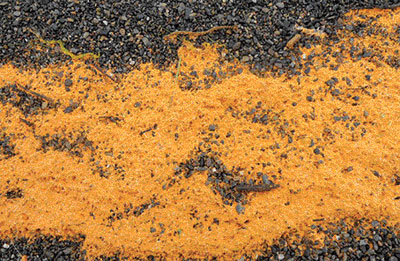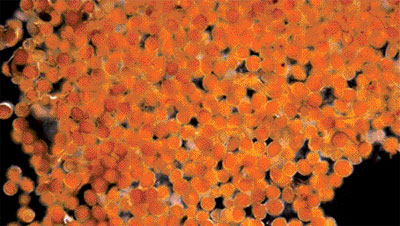|
IN FOCUS
Millions of microscopic eggs found in Alaska
Scientists have identified an orange-colored gunk that appeared along
the shore of a remote Alaska village as millions of microscopic eggs
filled with fatty droplets. Untill the mystery surrounding these eggs
was solved officials with the National Oceanic and Atmospheric
Administration said they did not know for sure what species the eggs
were although they believed they were some kind of crustacean eggs or
embryos. They also din't know if the eggs were toxic, and that worried
many of the 374 residents of Kivalina, an Inupiat Eskimo community
located at the tip of an 8-mile barrier reef on Alaska's northwest
coast.
 There's been at least one report of dead minnows found in the lagoon
of the village the night the eggs appeared last week. Residents were
also worried about the community's dwindling reserves in village water
tanks even though the orange mass has dissipated from the lagoon and
Wulik River, said city administrator Janet Mitchell."It seems to be all
gone," she said. "But if they're microscopic eggs, who's to say they're
not still in the river?" There's been at least one report of dead minnows found in the lagoon
of the village the night the eggs appeared last week. Residents were
also worried about the community's dwindling reserves in village water
tanks even though the orange mass has dissipated from the lagoon and
Wulik River, said city administrator Janet Mitchell."It seems to be all
gone," she said. "But if they're microscopic eggs, who's to say they're
not still in the river?"
Scientists also didn't know why the unidentified eggs suddenly
emerged on the shores of Kivalina last week. Villagers say they've never
seen such a phenomenon before."We'll probably find some clues, but we'll
likely never have a definitive answer on that," NOAA spokeswoman Julie
Speegle said.Samples were sent to a NOAA laboratory in Charleston, S.C.,
for further analysis. The Alaska Department of Environmental
Conservation also sent samples to the Institute for Marine Science at
the University of Alaska Fairbanks.
Kivalina residents live largely off the land, and many are worried
about the effect on some wildlife and plants from the goo (substance),
which turned powdery once it dried,,and probably went airborne. Mitchell
said some people went berry picking over the weekend, but couldn't tell
if the goo was on the fruit, called salmonberries, which are the same
color of the eggs.

The caribou are in the region now, but she doesn't believe the
migrating animals pose much risk as a food source.The eggs were found on
at least one roof and in buckets set all over the village to collect
rain water. City Councilwoman Frances Douglas said the gooey, slimy
substance was widely spread in streaks along the Wulik River and the
lagoon, which is a half mile wide and six miles long. Orangey water was
reported from as far away as the village of Buckland, 150 miles
southeast of Kivalina.Douglas estimated the volume of eggs she could see
"in excess of a thousand gallons, easily."
Even village elders don't recall anything like it, said Douglas, who
has lived all her 44 years in Kivalina. She remembers temperatures were
colder in her childhood, gradually rising over the years. The mystery of
the eggs was finally solved when they were identified as crustacean eggs
but why such a lot appeared suddenly is still a puzzle .
-AP

Plants and animals
1. An eagle has a wingspan of more than 2 metres but its body weighs
less than 4 kgs. True/false?
2. What is a locust?
3. Birds have air sacs linked to their lungs which provide them with
extra oxygen when flying.True/false?
4. What is the Portuguese man of
war ?
5. Mushrooms have no roots,no stems and no leaves. What are they
classed as?
Human body
1. How many kidneys does a human have?
2. The human body has 639 muscles and about 100 joints which assist
in mobility.True/false?
3. There are distinct regions in the tongue where the four different
tastes; sweet, bitter,sour and salty can be tasted.Which are the regions
for each taste?
4. We have around 10,000 taste buds on the tongue.True/fasle?
5.Inside each human eye, there are almost 130,000,000 light sensitive
cells. True/false?
Planet Earth
1. Rivers are large water bodies floating along a channel to the
sea,lake or another river. Smaller water bodies are known as brooks.
What are water bodies smaller than brooks called?
2. A waterfall is formed when a river plunges over a wall of rock
called a cliff. If the waterfall is really big it is termed a contract.
If the rock wall is steeply slanted rather than vertical, by which name
is the rushing waterfall called?
3. Small pieces of rock splinter and separate from huge rocks all the
time due to the elements. what is the loose broken rock which builds up
on the mountain side known as?
4.Where are caves generally formed; in areas rich in minerals, sand
or limestone?
5. Block mountains are made as a result of breaks or faults in the
earth. How are folded mountains formed?
**************
ANSWERS
Plants and animals
1. True
2. It is a large grasshopper that generally likes to live a solitary
life.However, when the population builds up they mass together and
migrate. They have devastated farmland throughout Asia and Africa for
thousands of years. A swarm of locust can be as large as 100000 million.
3. True
4. The Portuguese man of war is a species of large jellyfish which
can cause serious injury to a human. It can kill and eat a full sized
mackerel.
5. Mushrooms are classed as fungi;which means they have no
chlorophyll to manufacture their own food.
Human body
1. Humans have two kidneys .They work by effectively removing the
majority of waste from the body.
2. True. Each muscle has about 10 million muscle cells . The joints
have different levels of mobility.Some move like a single door hinge
(elbow and knees) while others, such as the base of the thumb or
shoulder, do so in all directions .The spine allows only a small amount
of movement.
3. The sweet taste is detected at the tip of the tongue while the
bitter taste can be felt at the back. The salty and sour tastes are
experienced from taste buds located on the two sides.
4.True.
5. True.
Planet Earth
1. Water bodies smaller than brooks are known as rivulets.
2. A cascade
3. The loose broken rock is called seree. When a mass of seree is
mixed with torrents of mud sliding down a mountain it is known as a
rockslide.
4. Caves are generally formed in areas rich in limestone.
5. Folded mountains are formed when layers of rock are squeezed by
pressure into large folds. |

